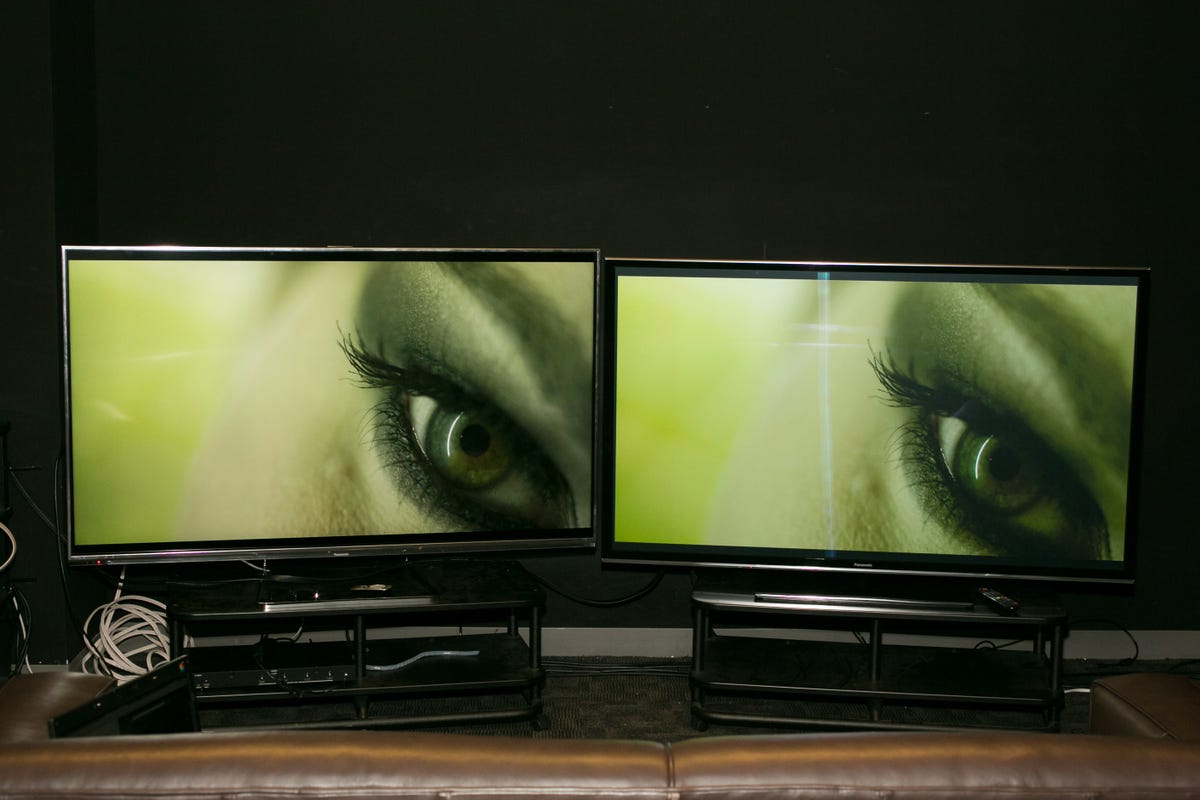
Sarah Tew/CNET
After a couple weeks of sleeves-rolled-up, dark-room, side-by-side testing — peppered with wrangling 4K sources, juggling newfangled gear, and chatting up industry colleagues — I’ve finally been able to publish a couple of reviews of name-brand 4K TVs.
These two expensive 65-inch 4K TVs, the Samsung UN65F9000 and the Panasonic TC-L65WT600, join the 50-inch Seiki SE50UY04 I reviewed back in May.
My full write-ups of all three total about 15,000 words, made up of 86,000 characters. That’s 616 maxed-out tweets.
Too long; didn’t read? Here’s the abbreviated version.
With video on a TV, the difference between 4K/UHD and 1080p/HD resolution is really hard to see. Many of the words in those reviews were written on a laptop in my lab at a theatrically close seating distance, comparing a 65-inch 1080p and a 65-inch 4K TV. Despite all the extra pixels I knew made up the 4K TV’s screen, most of the time I didn’t see any difference at all, especially with HD TV shows and Blu-rays. The differences in detail I did see were limited to the very best 4K demo material. Larger TVs or closer seating distances make that difference more visible, as do computer graphics, animation, and games, but even then it’s not drastic.
Don’t expect the kind of improvement afforded by higher computer monitor, tablet, and phone screen resolutions, like Apple’s Retina Display. That analogy is largely irrelevant to TVs because you watch TVs from across the room, not inches from your face.
Related stories
- What is 4K?
- Price comparison: Every current 4K TV
- Why 4K TVs are a bad idea
- 100GB discs point to 4K Blu-ray
- Sony’s 4K TV media player lands July 15
- HDMI 2.0: What you need to know
- HDMI 2.0 upgrade path: Where do the manufacturers stand?
- Best 4k TV’s
If you want the best picture quality in an LCD next year, you may have to buy a 4K TV anyway. The high-end 4K TVs I tested deliver very good picture quality — and for these prices, they’d better. All 4K flat-panel TVs on the market use LCD panels illuminated by LEDs, and employ some of the best picture-enhancing features available to the breed.
Local dimming of LED backlights is a prime example, and it usually makes every LCD TV perform better. It’s easy to imagine a near future where local dimming — or another effective picture quality enhancement that has nothing to do with resolution — is only offered on the more expensive TVs in a manufacturer’s lineup. You know, the ones that also happen to have 4K resolution. In fact, that’s exactly what happened with 3D and Smart TV; you typically have to get these features if you want premium picture quality.
Speaking of picture quality, none of the LED LCDs I’ve tested in the last few years, 4K or otherwise, can beat the best plasmas, let alone OLED. But plasma’s future is questionable at best, and OLED TVs will likely remain mega expensive for the next few years.
Despite the lack of content, 4K TVs will get inexpensive and popular very quickly. LCD TVs are easy to manufacture at 4K resolution, so mainstream-level prices will arrive very soon. Panasonic predicts 40 percent of 60-inch-plus TVs sold in 2016 will be 4K. DisplaySearch predicts that if LCD panel makers achieve their target of shipping over 30 million 4K TVs in 2014, “4K will quickly become the most adopted TV feature.” Affordable 4K TVs are booming in China, and names like Seiki and TCL are entering the US market with cheaper 4K TVs, currently around $1,000 for 50 inches, putting further downward pressure on prices.
4K TVs won’t make 1080p TVs obsolete anytime soon. A few 4K sources, primarily YouTube videos, are available now. More are likely coming next year in the form of Netflix streams, the first 4K Blu-rays, and non-proprietary video download/streaming services. But it will still take many, many years for TV broadcasters and producers to replace all their HD equipment with 4K cameras and gear. And when they do, there’s no guarantee those broadcasts actually look better than their HD equivalents. Even today, HD channels vary widely in quality, mainly because of bandwidth constraints, not resolution differences.
In the meantime, a standard 1080p TV bought in the next few years will remain perfectly viable for as long as you own it. Sure, it might not be able to play the most cutting-edge 4K content at 4K resolution, but you probably wouldn’t be able to tell the difference anyway.
To get our recommendations for what’s on the market right now, check out our always-current list of the best TVs.


Now playing:
Watch this:
Samsung UNF9000 4K TV review: Extra money for little…
3:32




